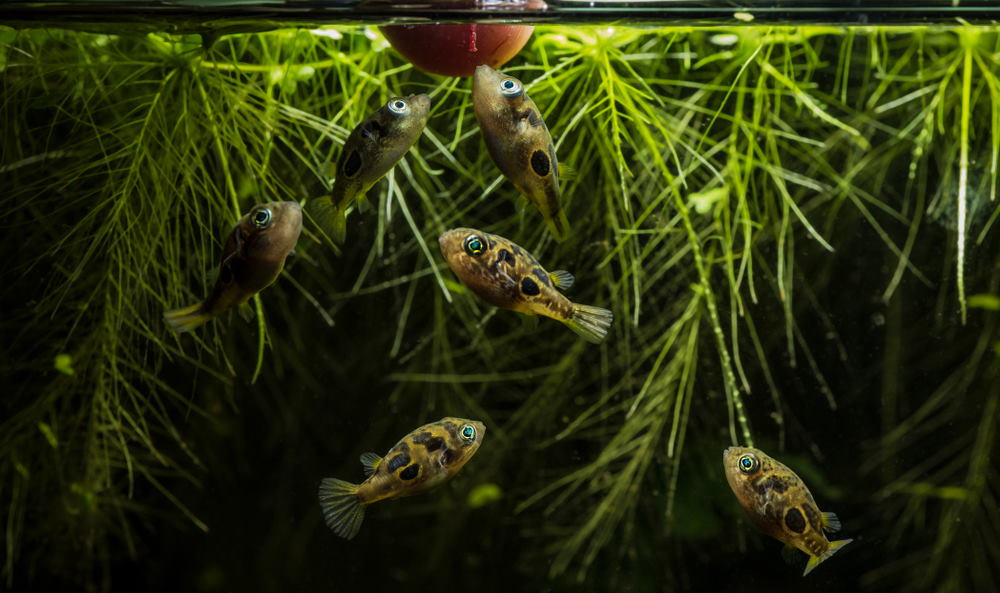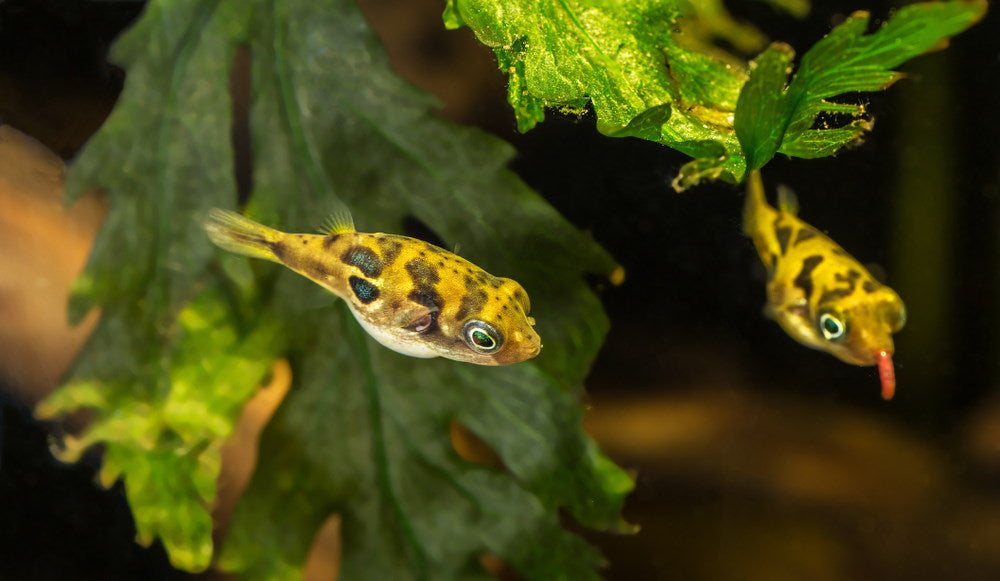Care Guide for Pea Puffers – The Smallest Pufferfish in the World
Pea puffers are one of the coolest oddball species you can keep in a smaller-sized aquarium. They’re known for their helicopter-like maneuverability, independently moving eyes, and of course, ability to inflate like a tiny water balloon. In this practical care guide, we answer your most frequently asked questions about these amazing, little creatures.
What Is a Pea Puffer?
Carinotetraodon travancoricus – also known as the pea puffer, Indian dwarf puffer, Malabar puffer, and pygmy puffer – is the smallest pufferfish in the world and comes from fully freshwater environments in the southwestern tip of India. Growing only to one inch long, they’re sold for anywhere from $3 to $15 at your local fish store (usually not available at pet store chains). When choosing your pet puffer, make sure to pick a healthy fish with a nicely rounded belly. It also helps to ask the fish store employees what they feed the puffers since they can be picky eaters.
Nowadays most pea puffers are captive bred, but if they’re wild caught, they may need additional deworming medication. We’ve used our quarantine medication trio as a preventative treatment on thousands of pea puffers with no harmful effects.

Even though puffers are considered “scaleless” fish, these three medications are proven to be safe for them. Make sure to use the full recommended dosages on them, or else pathogens may survive the treatment.
Do Pea Puffers Puff Up?
Yes. It is rare, but you may catch your pufferfish in act of puffing up as a defensive mechanism or just for practice. Pufferfish puff up by sucking in water to increase their size and discourage would-be predators. If let alone, it will shrink back down to its normal shape in due time.
Please do not deliberately stress out your pet to “make” it inflate. Instead, you can find plenty of pictures and videos online to see what it looks like. Also, if you need to move or transport your pea puffer, it’s best to use a cup or small container (instead of a net) so that the fish remains submerged in water at all times and won’t accidentally suck in air.
How Many Pea Puffers Can You Have in a 10-Gallon Tank?
Given how territorial pea puffers can be, many people have a lot of success keeping just one pea puffer in a five-gallon aquarium by itself. If you want to keep more than one, the general rule of thumb is to provide five gallons of water for the first puffer and three gallons of water for each additional puffer. In other words, it is possible to keep three puffers in a 10-gallon tank and six to seven puffers in a 20-gallon tank, but your rate of success depends on how well you set up their environment. If the tank is mostly bare without a lot of cover, expect to see a pufferfish battle zone. If you have a lush, densely planted aquarium, you might be able to handle three puffers in a 10-gallon space.
Of course, the larger the aquarium, the better. More water volume provides more dilution of waste (since poor water quality can harm your puffer’s health), as well as more space for the puffers to avoid each other. Plus, having a ratio of one male for every two to three females tends to decrease aggression, but most pea puffers are sold as juveniles, which are hard to sex. If you find yourself in a situation where you purchased three young puffers and ended up with one female and two males, you may need to rehome at least one male to minimize the fighting.

Up to six or seven pea puffers can be kept in a 20-gallon aquarium (with no other tank mates) if you provide lots of cover in the form of aquarium plants or decorations.
How Do You Tell the Difference Between a Male and Female Pea Puffer?
It can be a little tricky, but males tend to have deeper coloration with a stripe or dot on their belly. Their bodies are on the slenderer side, and they exhibit more aggressive behavior in general. Females, on the other hand, have a yellow belly and tend to be plumper in shape.
Do Pea Puffers Need a Heater?
They do well in stable, tropical temperatures from 74 to 82°F, so if your room temperature is below this range or tends to fluctuate a lot, you need an aquarium heater. For more information on what size heater is right for you, read our full article here.
In terms of other tank parameters, people have kept them at pH levels of 6.5 to 8.4. A pH range between 7.2 to 7.5 is ideal, but it’s more important to keep the pH levels stable rather than aim for a specific number. Because they’re not the fastest swimmers, you should also use a gentle filter with a slower flow rate.
What Do Pea Puffers Eat?
These hardcore carnivores are best fed on a diet of frozen foods (like frozen bloodworms and brine shrimp) and live foods (like little pest snails or blackworms). They typically will not take dry foods, but we’ve had good luck with Hikari Vibra Bites because they look and even move like bloodworms as they’re sinking.
Most larger pufferfish must be fed hard, crunchy foods to grind down their ever-growing teeth, but thankfully pea puffers don’t have this problem. Therefore, if you can’t get a hold of live snails, it’s not a dealbreaker. Just make sure to feed a wide variety of frozen foods so that they get all the essential nutrients they need to live a long and healthy life.

Frozen bloodworms are a favorite food for pea puffers, but offer them a diverse assortment of foods to ensure they have a well-rounded diet.
Can Pea Puffers Live With Other Fish?
This is one of the most common questions we get about pea puffers, and it’s not an easy one to answer. Some puffers can be a little timid, but most are pretty aggressive and territorial. Think of it like owning a dog that’s prone to fighting. In most cases, any other dog or pet you bring home will probably get attacked. If they don’t, that’s great, but it might not be worth the hassle of finding your dog a roommate when you know the odds of friendship are not likely.
Therefore, if you want to keep pea puffers, buy them with the expectation of keeping them in a species-only aquarium with no other tank mates. This means that you won’t be able to add any algae eaters or clean-up crew, so you’ll have to do more tank maintenance yourself. Pea puffers can be a little messy, especially if they don’t catch every bit of food that falls in the water, so it would be beneficial to use live aquarium plants to help consume the toxic waste compounds. Ideally, a well-balanced, densely planted tank has very little algae growth, and it provides a beautiful underwater jungle for your little helicopter fish to navigate.
Are Pea Puffers Good Pets?
This oddball species is more of an intermediate level fish, so we generally don’t recommend them to first-time fish keepers. They have special dietary requirements and don’t get along with other community fish. That being said, pea puffers are very inquisitive, have unique looks and behaviors, and can even learn to recognize you as their owner. If you’re looking for an amazing water pet that can live on your desk or kitchen counter, try a pea puffer and you won’t regret it!

Pea puffers are very curious fish with excellent eyesight, so you’ll often see them carefully examining everything in their aquarium.
For more care guides like this, sign up for our newsletter to receive a weekly email with all or our latest blog posts, videos, and live streams!




